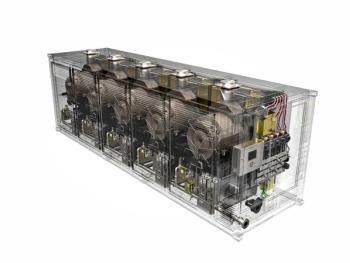
TROUBLESHOOTING AND OVERHAUL OF A COMPRESSOR BUNDLE ASSEMBLY
ONSITE SPARES CAN BE A GOOD INVESTMENT
A centrifugal compressor, packaged by Cooper Industries (now part of Rolls- Royce), was used in an offshore facility to compress natural gas. It was a three-stage assembly: from 6 kg/cm3 to 90 kg/cm3 with two stages combined in the low pressure (LP) bundle and a third stage separately operating in the high pressure (HP) bundle assembly.
Efforts were taken to reduce the time required in overhaul once the maintenance staff identified unusual noises emanating from the compressor. With a rigid commitment in place to supply gas to users downstream, management demanded urgent completion of an in situ repair.
The HP bundle assembly was a horizontally split Kawasaki RB-7B with seven stages. It was oil lubricated, and oil sealed having internal stage separation of aluminum alloy labyrinths. The maximum throughput of natural gas was about 2.3 million standard cubic feet per day (mmscm/d).
The inlet pressure of the HP compressor was 30 kg/cm and discharge pressure was about 92 kg/cm. The compressor was driven by a Rolls-Royce MK-1535 gas turbine aerodynamically connected to a Cooper Power Turbine and a step-up helical box by Philadelphia Gears.
Sealing of the shaft was achieved through sets of aluminum labyrinth and a peripheral honeycomb combination with high-grade oil between the sealing surfaces. The compressor had a stationery casing with a horizontally split rotor assembly pushed and secured by a split-ring retainer system bolted on from the coupling side.
Problem detection
During operation on load, an unusual humming sound came from the HP and LP coupling area. This sound appeared to be emanating with a higher pitch from the HP bundle side. It began about 45 minutes after loading the unit or as soon as it reached its operating temperature. In addition, vibration parameters of the HP compressor had nearly doubled.
Engineers checked on the condition of the coupling shim. When found intact, they opened the bundle assembly and noticed a failure of the HP bundle O ring, which seals the space between the bundle and the casing. This generated abnormal noise due to HP gas at the discharge end seeking to find a way through the failed O ring area towards the HP suction side.
To fix the problem, they removed the drive-end seal assembly (Figure 1). The bundle sealing O-ring was damaged on the periphery over a length of about six inches (Figure 2).
During an earlier HP bundle repair job in a similar unit, activities that caused delays were:
1. Cleaning of bundle components (rotor, seals, labyrinth grooves)
2. Dismantling, cleaning, checking of seal assembly components and assembling with new components of seals
3. Fitting of new labyrinths on the bundle halves.
Management drafted additional manpower for time-consuming activities such as component cleaning and removal of the old labyrinths (about 27 in one half). During an earlier maintenance event, oil was used as a lubricant when sliding a labyrinth into the slot which resulted in delays and sometimes damage to new labyrinths. This time, grease was employed which aided in easy sliding of labyrinths on grooves without damage to the delicate aluminum alloy material of the labyrinths. This trimmed seven days off the project.
Maintenance analysis
Comparing the cost of carrying a spares inventory against lost revenues during an outage is important. This gas compressor, for example, handles about 2.1 mmscm of gas per day, thus earning around $8 million per day. The loss of income for an additional seven days made it clear that onsite spares can be a good investment.
Non-availability of a spare seal-puller plate (seen by the side of the seal assembly in Figure 1 and supplied by the OEM for removal and fitting of the seal assembly onto the bundle shaft) could have contributed to further delays.
Since only one puller plate had previously existed on site, two teams would not have been able to simultaneously work on seal assemblies at both ends. Therefore, puller fixture plates were fabricated locally before opening the compressor for repairs. This can save at least three more days in performing such maintenance.
During complex repairs of this nature, it can be difficult for the maintenance department to keep repair times down to an acceptable length. Thus it is important to analyze each activity and the resources used to explore ways of trimming days off the project and saving millions in the process.
Author
S. Krishnamoorthy, BE, is Associate Vice President Offshore Maintenance at Gujarat State Petroleum Corporation Ltd (GSPC). For more information, visit www.gspcgroup.com
Newsletter
Power your knowledge with the latest in turbine technology, engineering advances, and energy solutions—subscribe to Turbomachinery International today.




